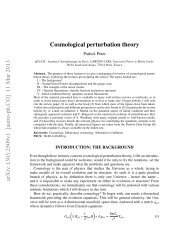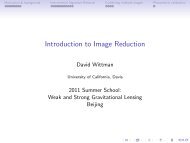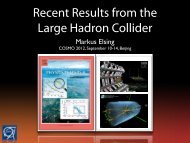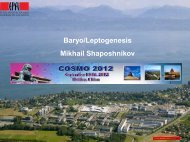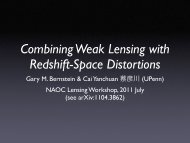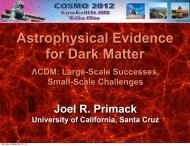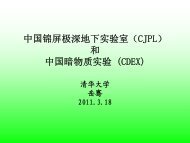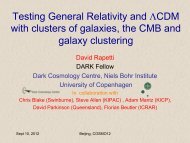Large-Scale Structure of the Universe and Cosmological ...
Large-Scale Structure of the Universe and Cosmological ...
Large-Scale Structure of the Universe and Cosmological ...
Create successful ePaper yourself
Turn your PDF publications into a flip-book with our unique Google optimized e-Paper software.
<strong>the</strong> size <strong>of</strong> <strong>the</strong> catalog <strong>and</strong> optimizing its geometry.<br />
In this chapter, we concentrate mainly on <strong>the</strong> point (iii). Dynamical biases<br />
mentioned in point (ii) will be addressed in <strong>the</strong> next chapter. These effects<br />
can also be taken into account in <strong>the</strong> formalism, by simply replacing <strong>the</strong> values<br />
<strong>of</strong> <strong>the</strong> statistics intervening in <strong>the</strong> equations giving cosmic errors <strong>and</strong> crosscorrelations<br />
with <strong>the</strong> “distorted” ones, as we shall implicitly assume in <strong>the</strong> rest<br />
<strong>of</strong> this chapter 57 . Segregation effects <strong>and</strong> incompleteness due to instrument<br />
biases, obscuration or to selection in magnitude will be partly discussed here<br />
through weighted estimators, <strong>and</strong> in Chapter 8 when relevant.<br />
This chapter is organized as follows. In Sect. 6.2, we discuss <strong>the</strong> basic concepts<br />
<strong>of</strong> cosmic bias, cosmic error <strong>and</strong> <strong>the</strong> covariance matrix. Before entering<br />
in technical details, it is important to discuss <strong>the</strong> fundamental assumptions<br />
implicit in any measurement in a galaxy catalog, namely <strong>the</strong> fair sample hypo<strong>the</strong>sis<br />
[500] <strong>and</strong> <strong>the</strong> local Poisson approximation. This is done in Sect. 6.3,<br />
where basic concepts on count-in-cell statistics <strong>and</strong> discreteness effects corrections<br />
are introduced to illustrate <strong>the</strong> ideas. In Sect. 6.4, we study <strong>the</strong> most<br />
widely used statistic, <strong>the</strong> two-point correlation function, with particular attention<br />
to <strong>the</strong> L<strong>and</strong>y <strong>and</strong> Szalay estimator [393] introduced in Sect. 6.4.1.<br />
The corresponding cosmic errors <strong>and</strong> biases are given <strong>and</strong> discussed in several<br />
regimes. Section 6.5 is similar to Sect. 6.4, but treats <strong>the</strong> Fourier counterpart<br />
<strong>of</strong> ξ, <strong>the</strong> power spectrum. Generalization to higher-order statistics is discussed<br />
in Sect. 6.6.<br />
Section 6.7 focuses on <strong>the</strong> count-in-cell distribution function, which probes<br />
<strong>the</strong> density field smoo<strong>the</strong>d with a top-hat window. In that case a full analytic<br />
<strong>the</strong>ory for estimators <strong>and</strong> corresponding cosmic errors <strong>and</strong> biases is available.<br />
Section 6.8 discusses multivariate counts-in-cells statistics. In Sect. 6.9 we introduce<br />
<strong>the</strong> notion <strong>of</strong> optimal weighting: each galaxy or fraction <strong>of</strong> space can<br />
be given a specific statistical weight chosen to minimize <strong>the</strong> cosmic error. Section<br />
6.10 deals with cross-correlations <strong>and</strong> <strong>the</strong> shape <strong>of</strong> <strong>the</strong> cosmic distribution<br />
function <strong>and</strong> discusses <strong>the</strong> validity <strong>of</strong> <strong>the</strong> Gaussian approximation, useful for<br />
maximum likelihood analysis. Section 6.11 reinvestigates <strong>the</strong> search for optimal<br />
estimators in a general framework in order to give account <strong>of</strong> recent<br />
developments. In particular, error decorrelation <strong>and</strong> <strong>the</strong> discrete Karhunen-<br />
57 Of course, this step can be non trivial. Measurements in galaxy catalogs (Sect. 8)<br />
<strong>and</strong> in N-body simulations suggest that in <strong>the</strong> nonlinear regime <strong>the</strong> hierarchical<br />
model is generally a good approximation (e.g. [87,234,147,150,472]), but it can<br />
fail to describe fine statistical properties (e.g. for <strong>the</strong> power spectrum covariance<br />
matrix [564,296]). In <strong>the</strong> weakly nonlinear regime, PT results including redshift<br />
distortions (Sect. 7.4), projection along <strong>the</strong> line <strong>of</strong> sight (Sect. 7.2) <strong>and</strong> biasing<br />
(Sect. 7.1) can help to compute <strong>the</strong> quantities determining cosmic errors, biases<br />
<strong>and</strong> cross-correlations. In addition to <strong>the</strong> hierarchical model, extensions <strong>of</strong> PT to<br />
<strong>the</strong> nonlinear regime, such as EPT, E 2 PT (Sect. 5.13) <strong>and</strong> HEPT (Sect. 4.5.6),<br />
coupled with a realistic description <strong>of</strong> galaxy biasing can be used to estimate <strong>the</strong><br />
errors.<br />
131



